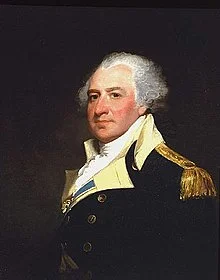Thomas Willing Chairs Two National Banks
Thomas Willing was an early leader in the American Revolution.
Although he was in the Continental Congress when the vote for independence was taken, Willing was not yet ready to separate from the Mother Country.
Thomas took a back seat for a few years but reemerged after the Revolutionary War ended to assist in creating America’s first two central banks.
Thomas Willing
Thomas Willing was born into one of the most prestigious families in Philadelphia.
At the age of 18, he returned from studying in England and began working in his father’s mercantile house. His father, who also happened to be Mayor of Philadelphia, passed away soon after.
Thomas and Robert Morris (an apprentice of Thomas’ father) took over the business. The company renamed itself Willing Morris & Co and the two men worked together for the next forty years.
Mayor of Philadelphia
Willing quickly climbed the political circles of Philadelphia, becoming an alderman, councilman and city court justice. At just 32 he was elected to his father’s old position, Mayor of Philadelphia.
After his term as Mayor, the Governor appointed Thomas as an Associaitate Justice of the colonial Surpeme Court of Pensylvannia.
When the American Revolution began, Willing had established him as a trusted leader in Philadelphia.
Hesitant Revolutionary
Willing was placed on the Committee of Correspondence and Committee of Saftey for Pennsylvania.
He represented his state to the Second Continental Congress, but like many men of Pennsylvania, he was hesitant to declare independence from Great Britain. When that moment arrived, Willing (along with Morris and John Dickinson) remained against separation.
When independence prevailed, Willing and his colleagues were quickly removed from the Continental Congress and replaced with more radical members. After this, Willing took a supporting role in his State until the Revolutionary War was won.
The Bank of North America
Thomas Willing’s most significant contribution to the American Founding came as the hostilities of war came to an end.
Robert Morris and Alexander Hamilton pushed a bill through the Confederation Congress which established a national bank. This bank would be a private company which sold shares to the general public and (mostly) the government. The United States owned almost 70% of the company’s stock while William Bingham purchased more than any other individual at just under 10%.
This national bank was named the Bank of North America. The Bank of North America’s first President was Thomas Willing.
Willing’s role here was to oversee the establishment of the bank’s policies and make it profitable. He successfully did this and, in turn, assisted in stabilizing America’s uneasy young economy.
The First Bank of the United States
Thomas remained as President of the Bank of North America for almost a decade.
When the new Constitution was ratified, and George Washington became President, Secretary of Treasury Hamilton began rethinking his ideas for a central bank.
Now he wanted a National Bank.
After some hefty political maneuvering, and negotiations with Thomas Jefferson and James Madison, Hamilton got his National Bank.
It was named the First Bank of the United States.
And who was the First President of the First Bank of the United State?
Thomas Willing of course.
Willing would direct the Bank of the United States for the first sixteen years of it’s existence. This includes the first three presidential administrations. He only evacuated the office upon his death in 1807.
Thomas Willing does not have a biography that I am aware of so, seeing as we discussed national banks so much in this article, I recommend reading ‘Reconstructing the National Bank Controversy.’ Although this book goes outside the scope of the Founding Period, it looks at many interesting aspects of the growth of the national bank in early America, arguments for and against its constitutionality, and effects it had on the size and power of the federal government. It ends with Andrew Jackson’s famous fight with the Second Bank.
As with all books recommended on this site, purchases are made through our affiliate Amazon and a very small portion goes to support this site. But only purchase the book if you can’t locate it at your library!
If you enjoyed this article and would like a new Founder every day, please consider subscribing to our email list here.






